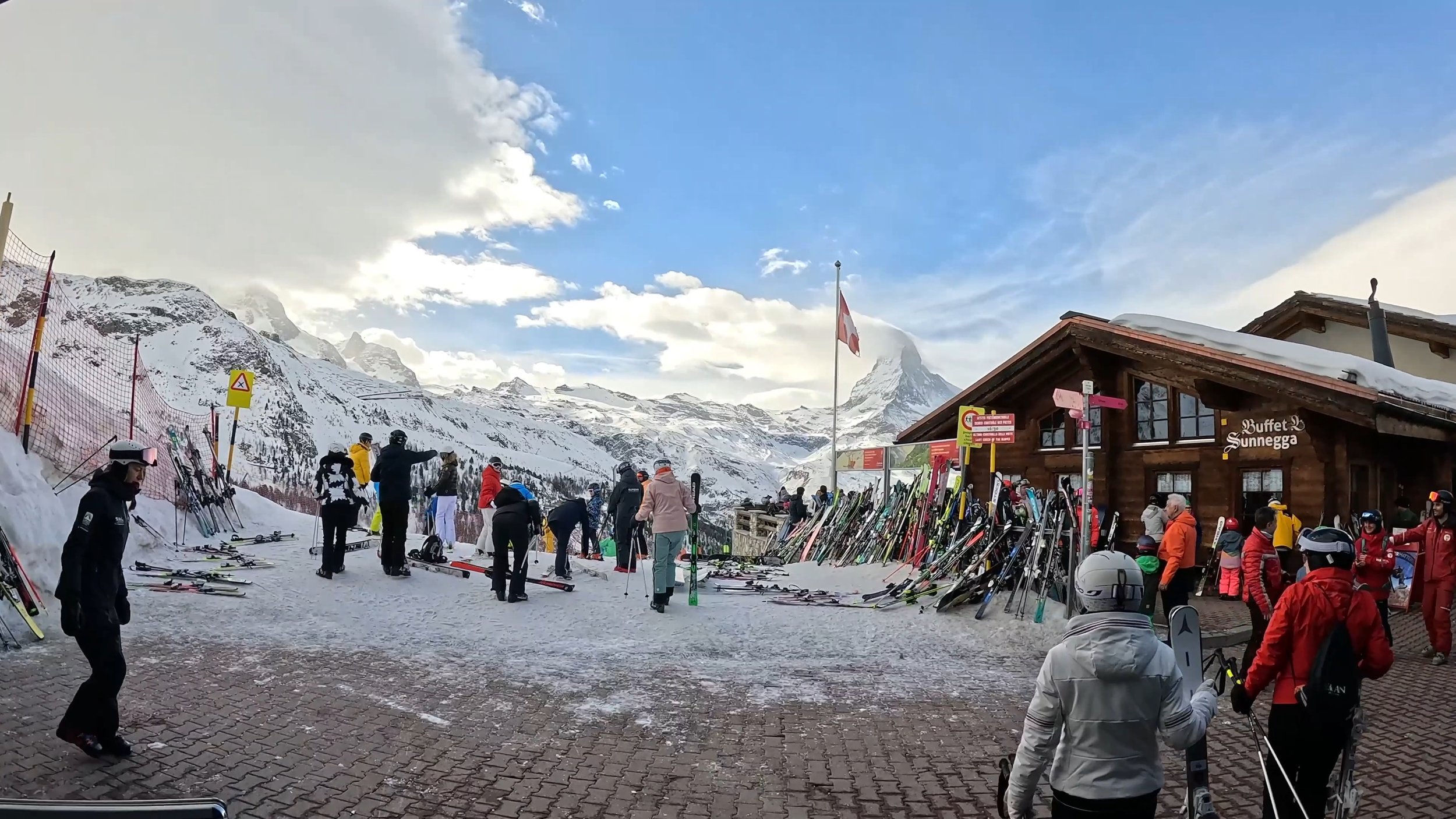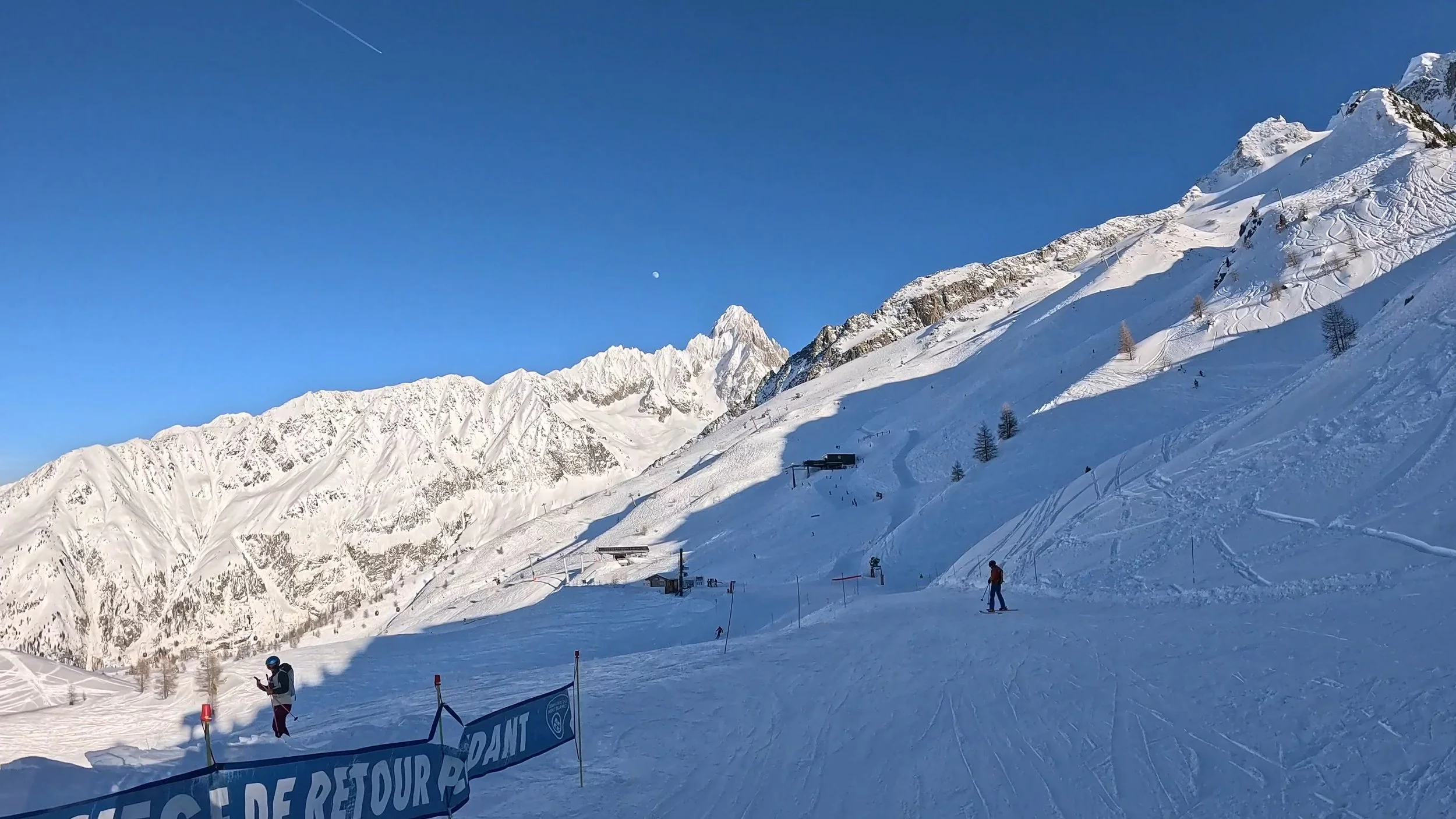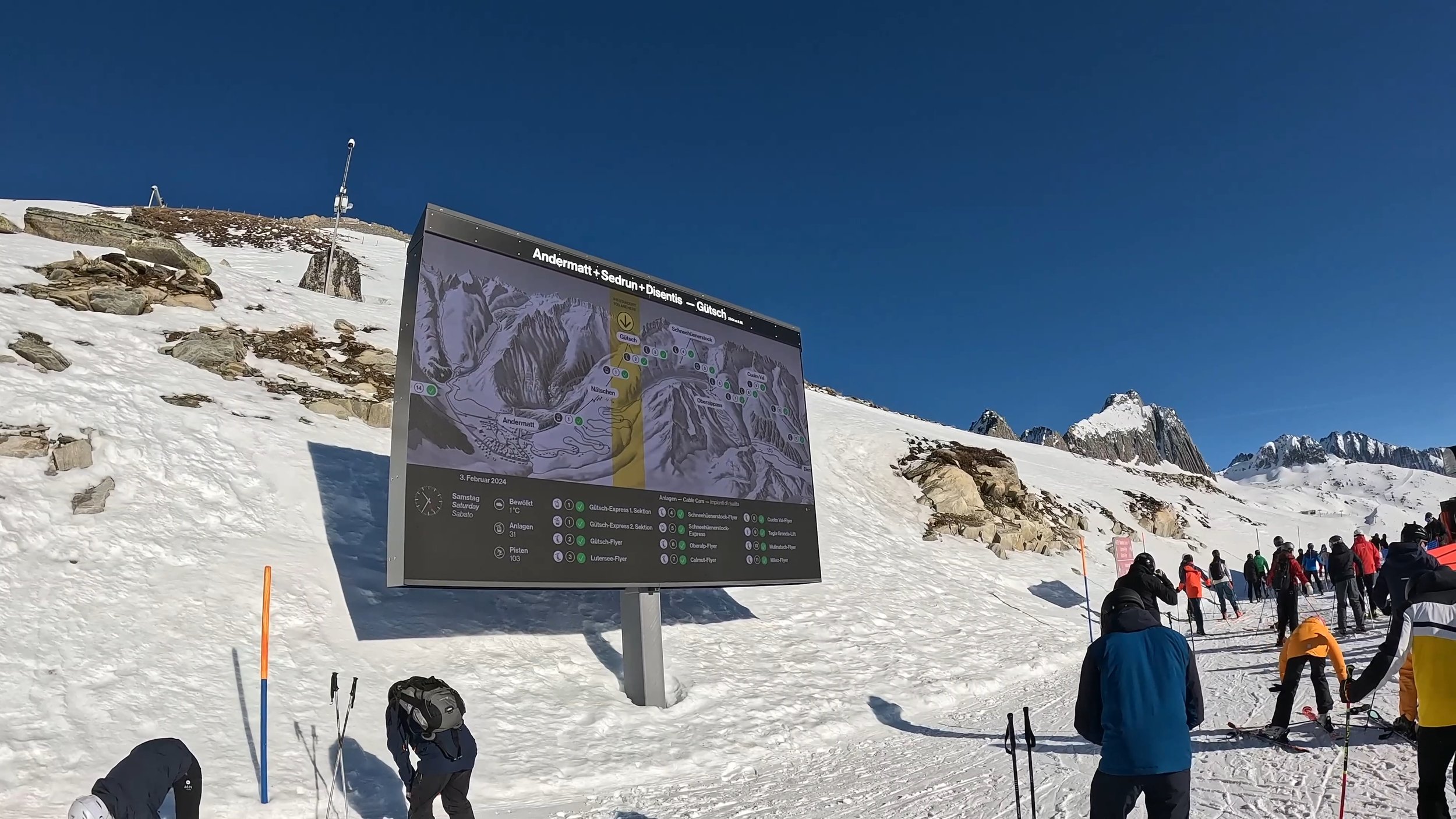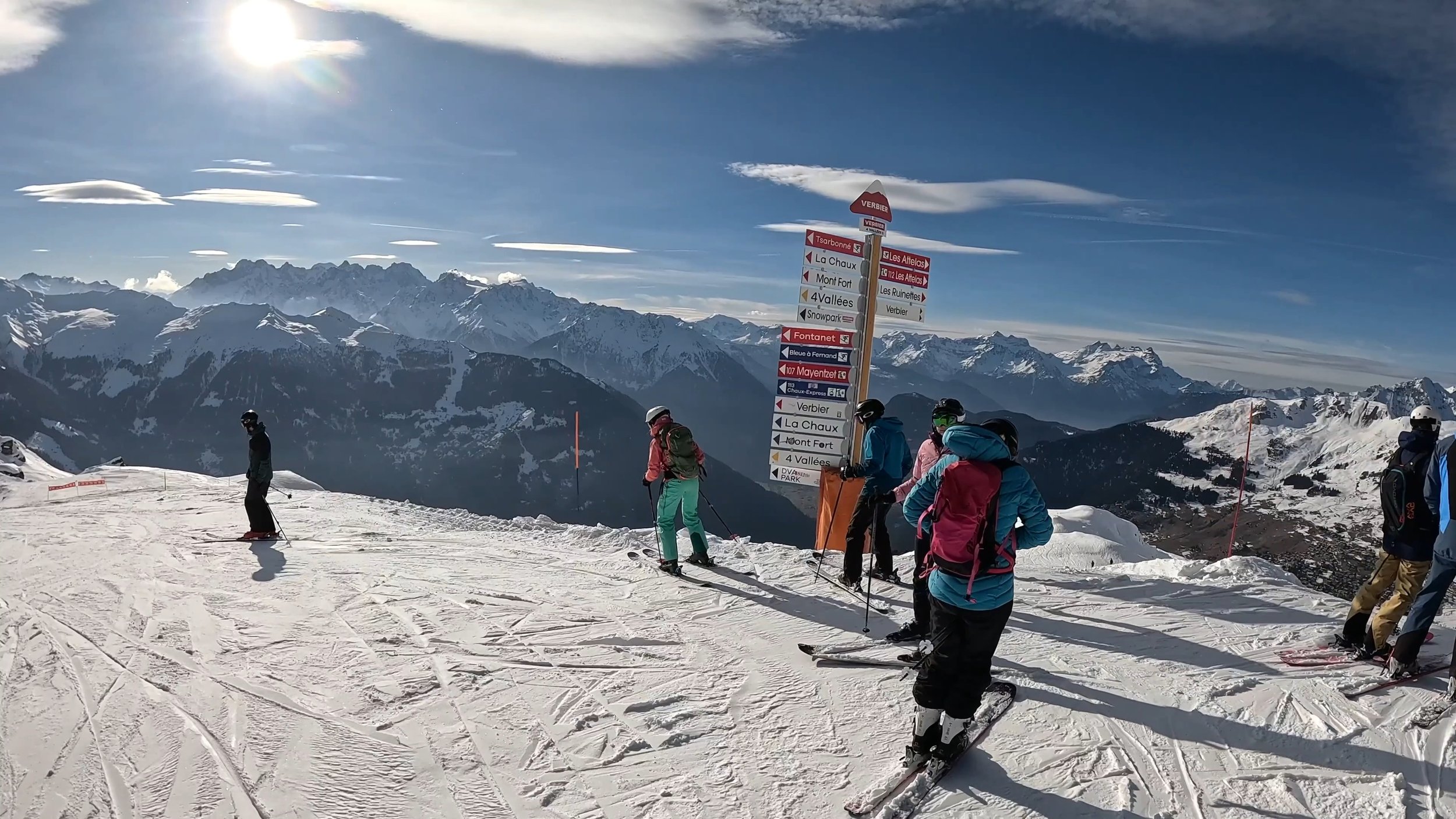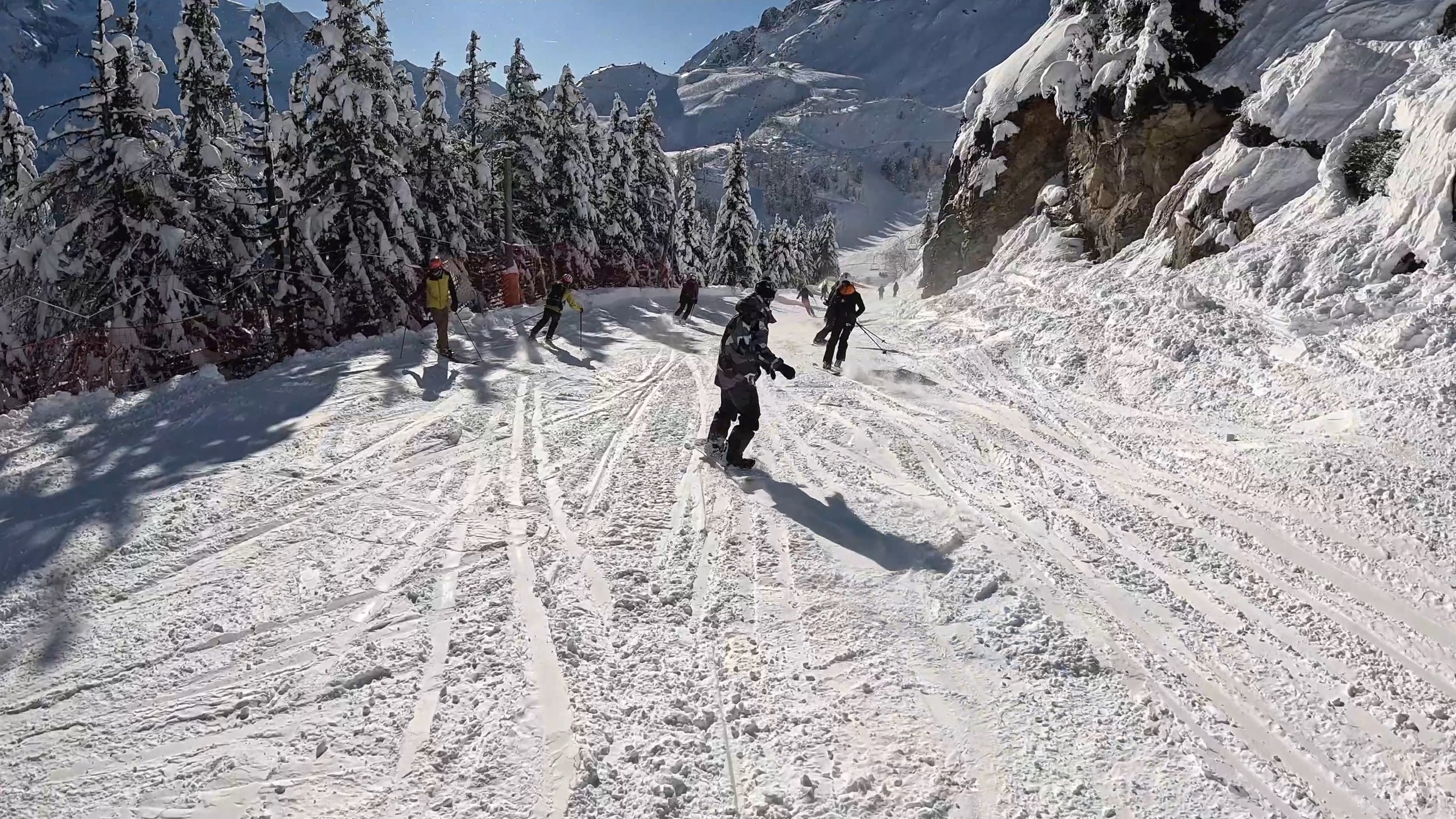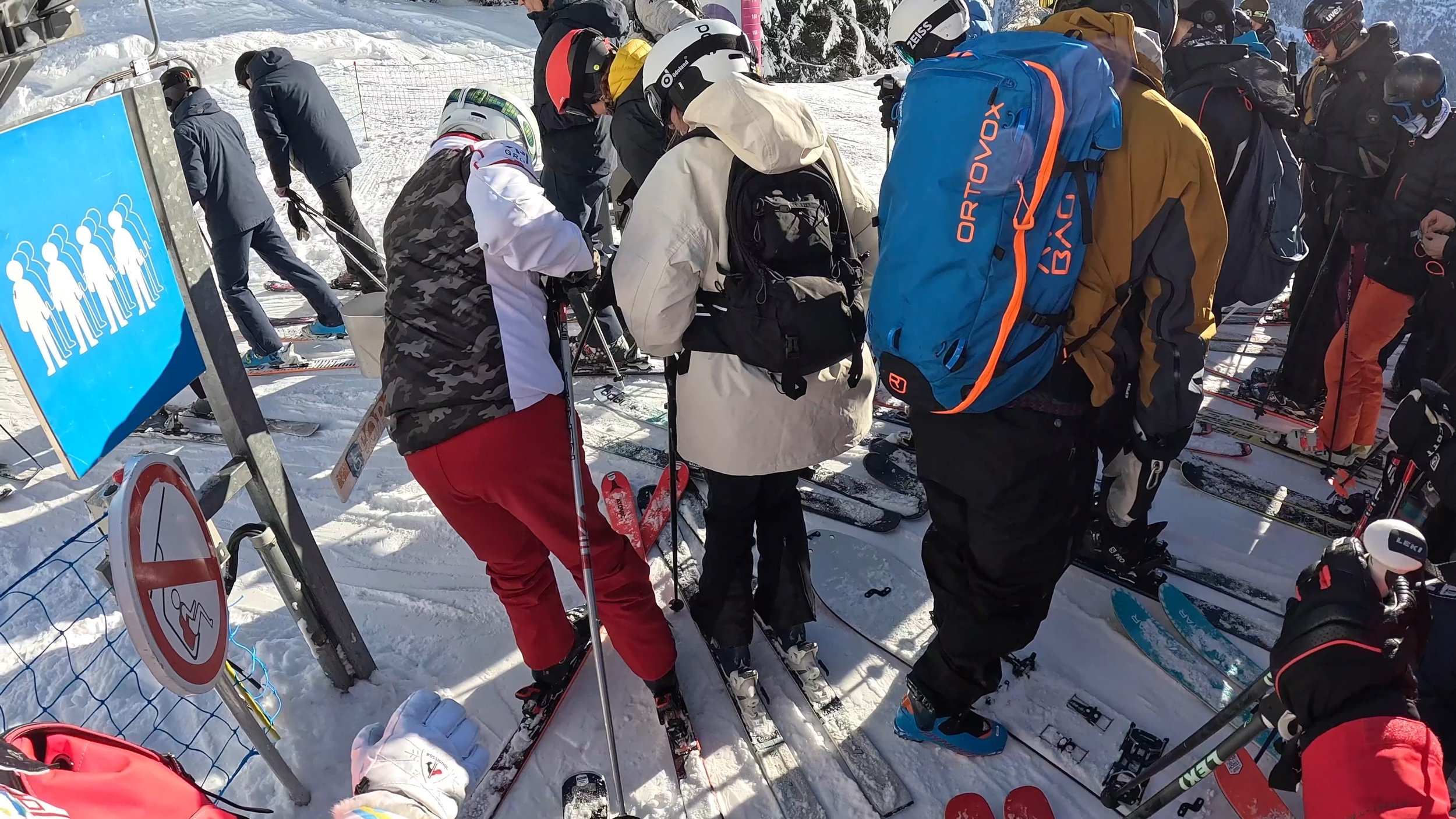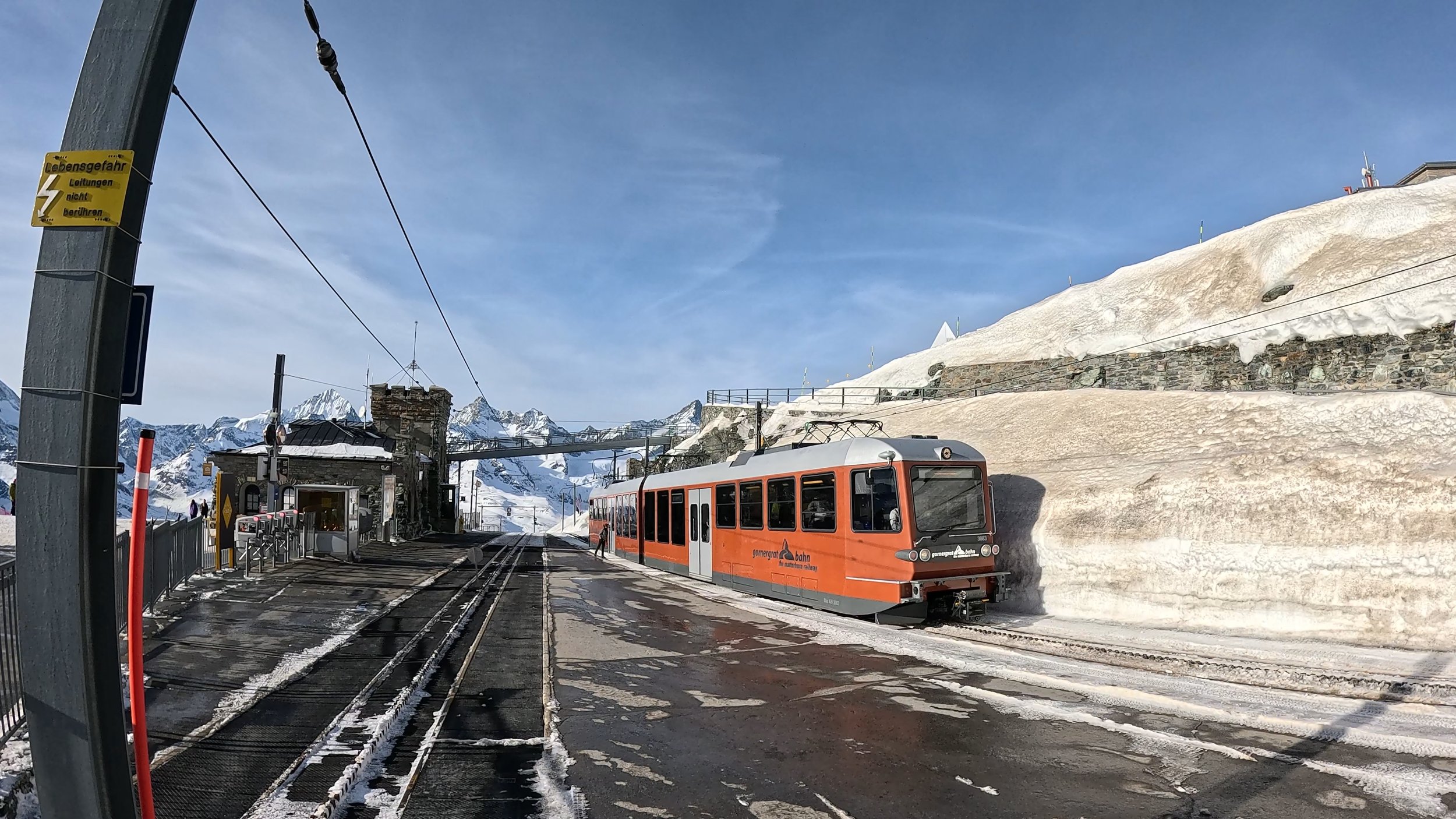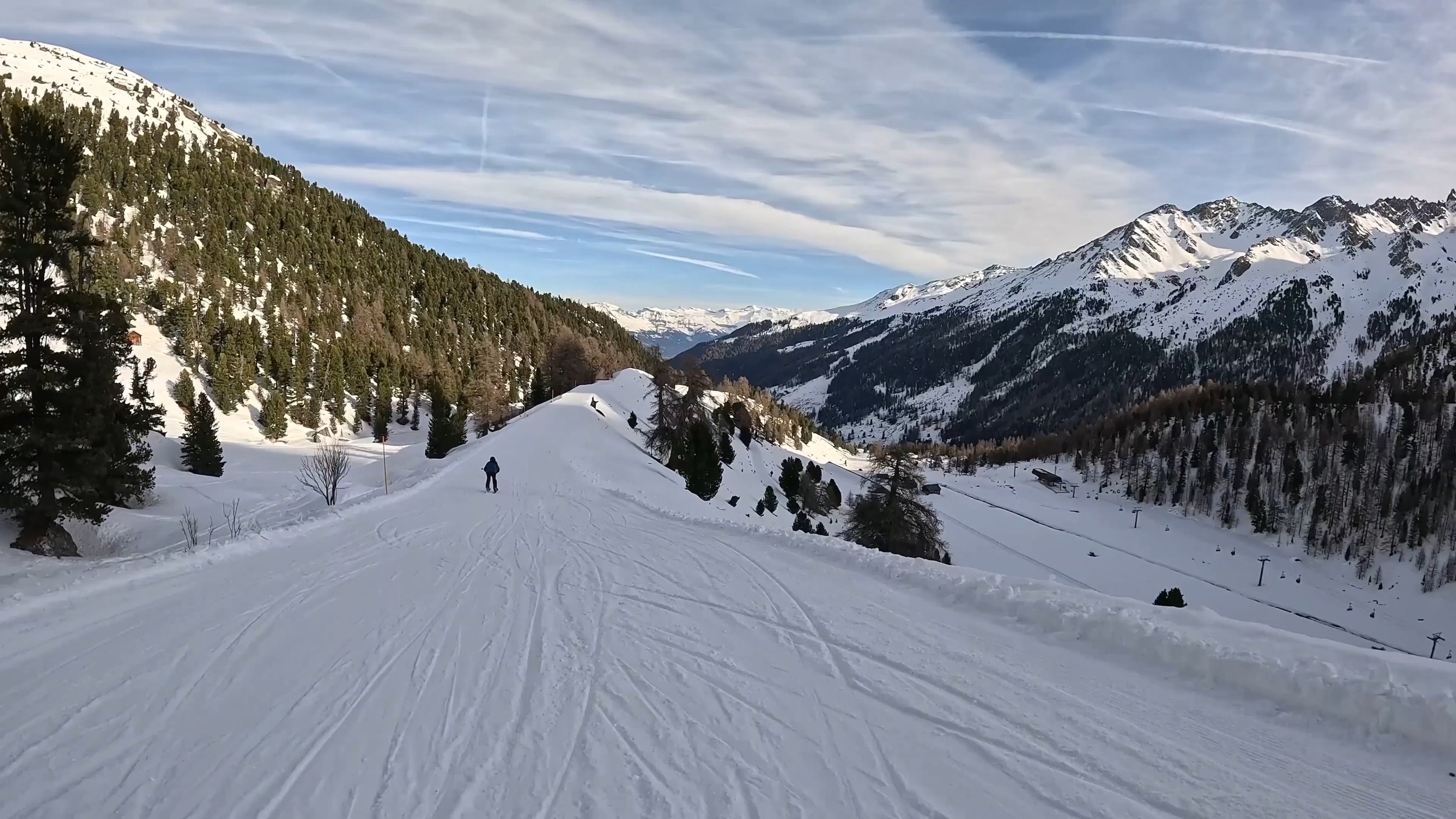The Most Shocking Things About Skiing in Europe — As an American
When it comes to skiing and riding, North America is one of the best places in the world you can be. But moving across the pond to Europe opens up a completely different world for alpine winter sports.
Sure, there are only so many ways one can get down a mountain, but Europe’s ski scene has evolved in such a different way than North America’s that it will leave first-time visitors shocked, with differences in just about every aspect of the vacation experience one can imagine. Our team just had the privilege of spending three-and-a-half weeks across six major ski areas in the French and Swiss Alps, and in this piece, we’ll go through the biggest differences you can expect from skiing in Europe versus a trip in the US or Canada.
The six French, Swiss, and Italian ski regions our team visited in recent weeks.
Mountain Aesthetic
The first thing that will stand out to any first time European Alps visitor is just how stunning the slopes are.
North America’s ski resorts are by no means ugly, but their European counterparts put them to shame, with some of the most stunning peaks anywhere in the world visible right from the resorts. If we want to get technical here, this remarkable beauty can especially be attributed to three main factors: the mountains' impressive prominence, their formation by glaciers, and their relative youth.
The Alps stand out dramatically against the landscape, with peaks often rising between 6,000 to 8,000 feet above the valleys where most visitors begin their journeys. These mountains are not just tall—they are also uniquely shaped by the glaciers that moved across them millions of years ago, sculpting them into forms unlike any other. And finally, since the Alps are much younger than all the major North American mountain ranges, including the iconic Rockies, millions of years of weather events have not had the time to literally “weather” down their unique topographies.
Europe’s stunning mountain peaks put those in North America to shame, and the much lower treeline makes for wide-open views.
Orient Towards Above-Treeline Terrain
While resorts in the US and Canada largely remain below treeline (albeit with high-alpine bowls in certain regions), Europe’s destination ski resorts are almost entirely void of trees, making for wide-open vistas with uninhibited views of the natural surroundings. But surprisingly, this circumstance isn’t directly a product of Europe’s ski resorts sitting at higher elevations than North America’s—instead, the treeline is a lot lower than that of the mountains across the pond, so trees ultimately stop growing at a much lower altitude than in the US and Canada.
As a result, Europe offers above-treeline slopes for exponentially longer stretches than even the most famous ski resorts for high-alpine bowls in North America, with below-treeline terrain only available in the lowest-elevation areas. Ultimately, a ski trip to Europe may be worth it for the views alone.
Places like Switzerland’s Zermatt offer vertical drops of over 7,000 feet (2,133 m), making for top-to-bottom runs that take around half an hour—and that’s if you book it.
Vertical Drops
Besides the incredible views and heavy orientation towards above-treeline terrain, Europe’s differences in topography make for some very noticeable distinctions in terrain layouts versus the US and Canada. Since the mountains are so prominent, the best European ski resorts offer vertical descents that are unheard of in North America. It’s especially easy to lose track of time with how long individual runs can be. Taking an hour across four or five lifts to get to the top of a resort is not out of the ordinary—and even if you book it as a confident skier or rider, it can take another 30-45 minutes to ski or ride from summit to base.
Resort Size and Interconnectivity
In addition, Europe’s ski resorts were often developed upwards from alpine villages in the valleys, with several neighboring mountains offering prime conditions for ski resort infrastructure. As a result, several neighboring ski resorts have grown to combine with each other, creating some of the largest continuously skiable areas in the world. Rather than one specific ski resort, many destinations in Europe consist of several interconnected “resorts”, with the largest mountains offering direct lift connections between what can officially be up to 5 or 6 separate entities. This makes for an almost incomprehensible amount of terrain to visit at Europe’s best ski destinations, and layouts that are just plainly impossible to fully cover in one trip.
Europe’s ski areas can go on for what feel like never ending distances, often involving up to five or six interconnected resorts rather than one singular mountain.
Getting Between Interconnected Resorts
The fact that Europe’s ski areas often consist of multiple technically separate resorts means that if you don’t know what you’re doing, it’s much easier to end up in the wrong place than at North America’s mountains.
While you can technically ski or ride between them, it might take five or ten lifts to get from one resort to another, and in the case of the biggest mountains, you might travel your way through one or two intermediate resorts on the way. The complexity of making your way across such lengthy and involved routes means it’s not always intuitive to get from Point A to Point B, and with so many lifts across these resorts—many of which can deceptively look like they go in the right direction but actually don’t—an involved study of the trail map is often required to make sure you don’t go the wrong way.
Consequences of Ending Up at the Wrong Place
In Europe, the consequences are much more dire if you end up at the wrong base area at the end of the day. Since the base villages for these resorts can be on opposite sides of mountain ranges, it can take as long as three hours to travel between them by car or public transportation. This means if you’re not in the right place after the lifts close, it can be incredibly expensive and time consuming to get back to your accommodation. In some cases, it may just make sense to book a hotel in the town you accidentally ventured into.
Getting between Europe’s interconnected ski resorts can take quite some time, and if you end up at the wrong place at the end of the day, you might be stuck there overnight.
Signage and Trail Map Differences
Navigating Europe’s ski areas can be frustrating even if you stay within the bounds of a singular resort. Since these ski areas are so big, it’s hard to convey all of the relevant information on a singular trail map, meaning the depictions often don’t do a great job of conveying the layout. These maps often lack critical lift and trail name information that’s typically standard on North American maps, making it fairly confusing to learn the layout of mountain areas at a minimum—and incredibly frustrating in the worst situations.
And while the quality varies across each individual ski area, on-mountain signage often lags behind the quality of that found at North America’s ski resorts. Pistes, or trails, are often marked by very small, easy-to-miss signs, rather than the large, rectangular signs that are nearly universal in North America. And even in places where lift and trail names are mentioned, if you’re not familiar with French, German, or Italian, the language barrier can make it tough to internalize the names of important resort areas.
Europe’s trail maps don’t always convey the same amount of information as those in North America, making it harder than one might expect to find certain trails or lifts.
Trail Difficulty Rating Differences
Besides the headache-causing circumstances we just mentioned, there are some other very significant differences in signage and resort symbols between Europe and North America.
The most conspicuous one is the difference in trail difficulty markings—while North American ski resorts almost universally use the green circle, blue square, black diamond, and double black diamond symbols to distinguish terrain ranging from beginner to expert, European resorts rarely use symbols at all, and typically use a blue color for easier trails, red for intermediate trails, and black for advanced or expert runs. At certain resorts, green may signify runs that are easier than blues, while yellow may signify runs that are either unmaintained or harder than blacks—but the basic blue, red, and black color scheme pops up essentially everywhere.
Since the vast majority of Europe’s ski areas sit above the treeline, resorts almost universally include poles on the sides of each trail to mark the edges of where they start and end. These posts are colored to indicate the difficulty level of the slope, and the left and right boundary sticks typically have slightly different designs to help guests stay in-bounds in low-visibility conditions. In France, number signs dispersed along the pistes mark how far you are from the end of the trail (many Switzerland resorts also have number signs throughout their pistes, but confusingly, they indicate the number of the trail, rather than any metric related to distance).
Europe uses a different trail difficulty rating system than North America, with most resorts typically using a blue color for easier trails, red for intermediate trails, and black for advanced or expert runs. Some resorts use green for beginner runs and yellow for freeride (ungroomed) pistes.
Off-Piste Terrain
This brings us to perhaps the biggest difference between European and North American skiing when it comes to resort design—in Europe, the managed and patrolled bounds of the ski area only consist of the marked pistes themselves. If you happen to go outside the bounds of one of the open trails, you are officially in backcountry terrain without any maintenance or avalanche mitigation work.
This makes for more dangerous conditions than one might expect from skiing or riding off a marked trail in the US or Canada; on top of the lack of avalanche mitigation, there are no markings for hidden obstacles such as rocks, cliffs, and crevasses—and, as should go without saying, no lift or trail markings either. There are no “bounds” to the off-piste, meaning if you venture off one of the marked trails, you could theoretically find massive swaths of incredible terrain to explore but not be able to get back within the bounds of the resort.
Due to these circumstances, those who choose to visit Europe should not engage in off-piste terrain without proper knowledge of the area, as well as avalanche training and equipment. We’d highly recommend checking out a service called Fatmap, which has information on informal off-piste trail names, difficulty ratings, and run lengths, and does a fantastic job of helping you navigate the extensive backcountry slopes that so many of these resorts have in droves. Those visiting may benefit from hiring a guide to navigate this type of out-of-bounds terrain, which typically goes for between €300-€800.
In Europe, any terrain outside of the marked pistes is considered backcountry. These runs do not see avalanche control and can host particularly extreme features.
Grooming Operations
At most European ski destinations, the marked pistes are decidedly mellow compared to the hardest runs in North America. European ski resorts tend to groom the overwhelming majority of their trails—including their expert-oriented blacks—meaning that in many cases, the off-piste is the only practical opportunity for moguls, chutes, and other demanding alpine features. This isn’t universally true for every ski area, and resorts with yellow-colored trails usually do not groom those slopes; however, ungroomed pistes are the significant exception, rather than the rule, in Europe.
With only a handful of exceptions, Europe’s marked pistes—including its black runs—see regular grooming.
Closed Trail Policies
It’s also worth noting that closed ski resort pistes work a lot differently in Europe than they do in North America. Unless active avalanche mitigation is underway, there is no penalty for entering closed areas at European ski resorts; in fact, if you duck a rope mere feet from the nearest ski patroller, they won’t do anything.
However, when pistes are closed in Europe, they are just as much backcountry terrain as other off-piste areas. While closed runs may be skiable—or at least seem that way from the top of the trail—they may pose significant avalanche risk, contain unskiable obstacles, or completely run out of snow cover in lower elevations. So while ski patrol won’t stop you, you still need to use your best judgment when deciding whether to ski or ride past a closed sign.
While ski patrol won’t stop you if you ski or ride past a closed sign, any roped-off areas are just as much backcountry terrain as other off-piste terrain zones.
Need for On-Mountain Insurance
If you do end up needing to be rescued—regardless of whether you are on or off-piste—it’s also worth noting that regular lift tickets do not come with insurance, meaning you will have to pay hundreds out of pocket for ski patrol services. This is in notable contrast to the US and Canada, where at least if you get stuck in bounds, these services are usually free of charge.
As a result, it’s extremely important to make sure to get the insurance add-on when you buy a lift ticket—and given how cheap this insurance is, it’s pretty much a no-brainer. Resort-provided insurance does not always cover off-piste though—and it’s not included if you’re using an Epic or Ikon Pass—so in these cases, you might need to get an insurance package separate from your resort access to make sure you’re covered, although it should still be fairly reasonable in price.
Europe’s marked ski pistes often have a higher density of skiers and riders than those in North America.
On-Piste Trail Congestion
So given that European ski resorts technically only consist of the marked pistes, does that mean that there’s a higher density of them per ski lift than in the states? Well, from our experience, it’s just the opposite.
It’s common for lifts to serve only two or three pistes apiece, and since these runs aren’t usually the widest in the world, they can get really congested. This makes it tough to avoid other skiers and riders and truly get into the flow of your runs, even if it’s not a particularly busy day.
Lift lines are basically free-for-alls in Europe, and visitors will often fight for their spot in the queue.
Lack of Line Management
Speaking of crowds, while lift lines have become a notorious subject in North America these days, they’re not exactly absent from Europe either. Peak-time queues can be really hard to avoid at the most popular resorts—with the problem becoming especially pronounced in mid-February, when several schools across European countries have winter break periods.
But unlike in the US and Canada, where resorts at least try to manage the queues for lift lines, it’s a complete free-for-all in Europe, where there’s no order in the lines and you basically have to fight for your spot in the queue. This results in a painful situation where even if there’s a 20 or 30-minute line for a lift, chairs or gondola cabins often do not load to capacity, which just compounds the amount of time that folks will need to wait in line. While singles lines could potentially help address this efficiency issue, at many European resorts, these one-person queues do not exist. In most cases, you really only get to skip the line if you pay for a ski lesson. At least if you go during an off-peak time, such as in January or March, lift lines are much less of an issue.
At its best resorts, Europe’s lift infrastructure far outclasses that of North America. Fancy bubble lifts, gondolas, funitels (pictured here), and aerial trams are widespread across the resorts.
Lift Infrastructure
Modern Lifts
So lift lines are a mixed bag, but what about the lifts themselves? Well it turns out that at the best mountains, Europe’s lift infrastructure is far more modern than that of North America. High-tech bubble lifts, gondolas, and funitels are the norm, not the exception, and aerial trams are a lot more widespread as well. Even the entrances to these lifts are fancier than in the US and Canada, and you’ll often use escalators to get you from the ground level to the loading area of your lift.
In certain cases, trains provide uphill and base-to-base transportation within Europe’s ski resorts.
Alpine Trains
But perhaps the most mind-blowing method of alpine transportation in Europe is its train network. Yes, it’s not just aerial lifts that take skiers and riders up the slopes in Europe—depending on the resort, guests can find themselves on cog railways running right up the ski slopes, or even underground funiculars that have literally been tunneled through the mountain. In some cases, train lines provide the main base-to-base transportation across particularly widespread ski areas. These train lines provide a completely different uphill journey than traditional ski lifts, and are sure to make for an unforgettable experience for those who are fortunate enough to use them.
Lift Network Downsides
However, Europe’s chairlifts aren’t universally better than those in North America. Just as in the States and Canada, less-destination-oriented ski areas still run a lot of slow, fixed-grip chairlifts. In addition, Europe uses a lot more t-bars and platters than in North America, and it’s common for certain mountain areas to only be accessed by these types of surface lifts. While they’re often faster than fixed-grip chairlifts, repeatedly riding platters and t-bars can get exhausting over the course of a ski day.
Finally, while Europe’s widespread aerial tram network means these lifts often don’t see the same lines as trams at North American ski areas, the mountains are a lot more lax with their tram headways too. Tramway operators often wait until the cabins are at 100% capacity to run the lift, meaning that in addition to the inherent nature of waiting for the cabin to arrive at the terminal in the first place, you might need to wait as long as 10-15 minutes for the cabin to truly fill up and actually start moving. This can be especially annoying if you choose to ride a tram over another lift because the cabin is right at the terminal, only to be stuck waiting for the cabin to move for a protracted period of time when you could have otherwise gotten another run in.
Not all of Europe’s lifts are fancy, and certain resorts use a lot more surface lifts than in North America.
Public Transportation
When it comes down to it, we’d give Europe the strong upper hand over North America when it comes to public transportation.
For most (but not all) of the major ski resorts in the Alps, there is reliable train or bus transportation to get from the airport to the ski slopes. The same holds true for lodging accommodations that aren’t directly on the mountain, with many resorts operating free regional bus services to and from the slopes.
Crucially, this means there is often no need to rent a car, saving guests from the dreaded winter-weather driving that is often mandatory for North American ski trips (or can only be avoided via private shuttles).
Extensive public transportation networks mean that at many European resorts, guests will not need to rent a car or private shuttle service to get around.
Snow Quality
Speaking of winter weather, how’s the actual snow in Europe? Well, it varies heavily by aspect and elevation, but if you go to the Alps expecting ample high-quality powder days like you might get in the Rockies, you might be disappointed.
The French, Swiss, and Italian Alps see high-quality snow when it arrives, making for incredible skiing and riding if you time the conditions right. But resorts can go for days or even weeks without significant snow events, resulting in sun-baked, icy conditions—and in recent years, these dry spells have been getting more and more common.
Combined with the high on-piste skier density, trails can get skied off and hard-packed quickly, making for less-than-enjoyable runs. Temperatures do usually remain mild and sunny when it’s not snowing, but this also results in freeze-thaw cycles, and makes the off-piste really inconsistent if it hasn’t snowed in awhile. It’s also worth noting that since European resorts often boast substantial vertical descents, the snow conditions tend to be much more variable in lower-mountain areas than upper-mountain ones, meaning that those who engage in top-to-bottom runs should be prepared for significant changes in trail conditions.
At least the European destinations do maintain a baseline level of resiliency thanks to lower-elevation snowmaking and protection from snowmelt in higher elevations, but in certain cases, the lowest-elevation trails may be closed, and guests should be prepared to download a lift rather than skiing or riding all the way down the mountain.
The snow quality at European Alps resorts can be quite strong on good days, but it’s nowhere near as consistent as that of the US and Canadian Rockies.
On-Mountain Restaurants
But even if the snow conditions are terrible, there is a significant upside for those visiting Europe’s destination ski mountains—the absolutely incredible restaurant and aprés scene.
Skiing in Europe isn’t just about the slopes themselves, it’s about the experience you have while on them, and guests will find authentic, independent, and high-end food and drink establishments across extensive reaches of the resorts. There are even some Michelin-star restaurants hidden across these mountains. Food at these chalets can get really expensive, but you get what you pay for, and it’s hard to find on-mountain restaurants with the same genuine vibes, quality food, and stunning views in North America.
Fortunately, cheaper food options aren’t out of the question either, and most resorts host establishments called “snack bars” that do specialize in lighter snacks but also have sandwiches that can easily make for a legitimate lunch.
Europe’s ski resorts host world-class restaurants right on the slopes, with some establishments even boasting Michelin-star statuses.
Aprés-Ski and Nightlife
And that brings us to the aprés—and guests will quickly find that Europe is just as much about the partying as it is the skiing.
At several notable destination resorts, on-mountain restaurants turn into what are essentially clubs by the afternoon, hosting live music and DJs and getting packed with skiers and riders. Some establishments don’t even do meals, functioning really only as bars. And the great thing is there are so many of these aprés venues that you can essentially do a bar crawl throughout the day, in some cases stopping in at four or five bars all along a single trail.
Pro-tip: the on-mountain bars tend to close around or just after the lifts close, so if you don’t time your departure to be a few minutes before that time, be prepared to deal with just about everyone tipsy skiing and riding down the trail and back to the base all at once.
Speaking of the base, the aprés fun does not stop once you’re off the slopes. Ski towns in the Alps host a variety of things to do, including bars, restaurants, and other entertainment options. You have to check out some of these venues to get a real sense of the European alpine culture, with the best establishments putting on top-notch shows that would never be found in an American ski town. While it might ruin their next ski day, visitors can easily find ways to keep the party going until 3am.
A couple of notable North American ski resorts do host lively towns that are somewhat comparable in terms of overall experience, but an incredible town experience is the norm, rather than the exception, in Europe.
Europe offers a much livelier aprés scene than North America, with lots of on-mountain parties and in-town venues that can stay open as late as 3am.
Ultra-Moneyed Vibes
But while the towns have plenty to do and the on-mountain infrastructure is fantastic, some of Europe’s ski resorts may take it a bit too far for some folks’ taste when it comes to the moneyed vibe. If you visit ski resorts such as Courchevel, Meribel, St. Moritz, and Verbier, they leave no question as to who they’re trying to attract, with ultra-luxury stores scattered through town, Gucci and Moncler-branded gondolas, and in the cases of Courchevel and Meribel, even private airports that are literally adjacent to the ski slopes. Resorts that cater this bluntly to the ultra-wealthy just do not exist in North America (or at least publicly). Aspen, Vail, and Deer Valley certainly carry elitist vibes themselves, but they’re not even close to this flagrant in extent.
Ski resorts like Courchevel might have Gucci-branded gondolas, but lift tickets in the Alps only top out around €85, making them hundreds of dollars cheaper than those at popular North American destinations.
Lift Ticket Prices
Ironically, that probably brings us to the most shocking discrepancy between skiing in Europe and North America—and that’s in the lift ticket prices.
Courchevel and other similar mountains may feel incredibly elitist, but even if you buy at the window, lift tickets only top out around €85, making them profoundly cheaper than traditional lift tickets in the states, which now regularly go for over $200 per day. If you buy in advance, tickets often go for much cheaper than this—even rates of closer to €50 or €60 are not unheard of.
As a result of this singular circumstance, North American skiers and riders who did not purchase an Epic or Ikon Pass before the season started will almost certainly recuperate any additional flight and restaurant costs. Or in other words, you can liberally enjoy the dining and aprés benefits of a European ski trip—and potentially still end up spending hundreds of dollars less than you would have by visiting Colorado or Utah instead.
Final Thoughts
Skiing in Europe is really a world of its own compared to the US and Canada, with differences in just about every aspect besides the act of sliding down the mountain. The European Alps may not have the same extreme in-bounds terrain and snow reliability as the other side of the pond, but with the price discrepancies between the two continents being lower than ever, now is a great time to consider pulling the trigger and booking a trip there.
For more information on destination ski resorts across North America and Europe, check out our North American ski resort rankings, and stay tuned for more Europe content!

